This site is made possible by its sponsors.
Please visit them!
d - An abbreviation for penny, which is derived from the "denarius" — a Roman coin. This abbreviation is also used in referring to sizes of nails: a "3 d nail" for instance is a "3-penny nail."
Also see numismatics.
dabber - A soft pad holding the wax ground used in etching.
![]()

![]()
dado - A square groove, cut, or depression.
Also see bevel, chamfer, corrugate, flute, and mortise.
daguerreotype or Daguerreotype
daho - In Japanese art tradition, a calligraphy technique, literally the "pressing method."
damar - A coniferous resin used as a varnish, and sometimes as part of mixed media.
dapping block or dapping die - A concave form used for forming metal. Pictured is one example. Dapping blocks vary in the number and form of their concavities.
Also see die, manipulate, and mortar.
dark, darkness - A shade; a color having low lightness and low saturation, and reflecting only a small fraction of incident light. When prepared by mixing pigments, a dark color may be achieved by mixing a large amount of black with little or no amout of one or more hues — only to the degree that it remains very neutral in color. Opposite to dark colors in saturation — highly saturated, but just as low in lightness — are called deep colors. The opposite of dark colors in their value — much lighter in value, but just as low in saturation — are called pale colors. Opposite to dark colors in both value and saturation are brilliant colors.
Quote:
Also see black, brightness, chiaroscuro, darkroom, day for night, gray scale, light, night blindness (nyctalopia), nocturne, pastel, positive, shade, and tenebroso or tenebrism.
darkroom - Light-tight room used for processing or printing photographic materials. Also see dark.
dawning realism stage - The third of the Stages of Artistic Development named and described by Victor Lowenfeld, it typically occurs in children during the ages of 9 to 11. This stage is typically preceded by the schematic stage (6-9) and followed by the pseudorealistic stage (11-13).
Related links:
Also see children's art.
day for night - The common name for a cinematic filter used to make a daylit scene appear to be a nighttime dark one. It is charmingly known to the French as a Nuit Américaine.
Also see night blindness (nyctalopia) and nocturne.
day-glo colors or DayGlo colors - Also called fluorescent colors and neon colors, day-glo colors are especially bright, clean materials which can be much brighter than conventional colors. They were first developed in the 1930s, finding their way into magic shows, stage shows, and movie promotion posters. They contain certain dyes and resins that produce colors far brighter than traditional pigments, and that had the unique effect of "glowing" under ultraviolet or black light. Day-glo colors are exceptionally bright under many different conditions, including indoor lighting, low light outdoors, and in limited visibility areas. Studies have shown that day-glo colors are noticed first. They grab the attention of the observer. Fluorescent colors are widely used to get attention, focus attention on an object, warn people of a potentially hazardous situation, get an object, person or situation noticed, etc. They are commonly used for traffic cones, detergent packaging, tennis balls, fishing lures, etc., and can be found in a wide range of media, including oil and acrylic paints, inks, dyes, markers, crayons, etc.
Example:

Peter Halley (American, 1953-), A Perfect World, 1993, acrylic,
day-glo acrylic, and Roll-a-Tex
on canvas, 90 x 147-3/16 inches.
See Neo-Geo.
Related resources:
Also see glitter, graphic design, ink, iridescence, light, luminous paint, opalescent, paint, signage, and ultraviolet.
D.B.A.E. - See discipline-based art education.
deaccession - To remove an artwork from a museum's collection, or the artwork that is removed. Works are typically deaccessioned through sale or exchange in order to acquire other works; rarely to support any other financial needs. During the art market of the 1980s, when prices were driven up by speculators, some museums resorted to the sale of what were considered secondary or redundant pieces in order to raise funds to acquire others. This is a controversial practice, raising questions as to whether such decisions reflect current tastes and will stand the test of time. Criticism is especially harsh against the deaccessioning of donations.
(pr. DEE-ak-SE-shən)
Also see accession, bad-debt art, commodification, gallery, and registrar.
deadline - The time or date by which something must be accomplished. For an artist, typical examples are: the hour by which works must be delivered to a patron or employer, or an application must be submitted to an exhibition committee. Agreeing to meet a deadline is usually considered a serious promise. Depending upon the objective, failure to meet a deadline can result in a lowered grade, exclusion from a competition or other opportunity, or even in a damaged reputation or loss of income. Chronic failure to meet deadlines can devastate a career.
Here is a great resource:
Also see graphic design.
dead white males - See DWM.
death mask - A cast of the face of a dead person, a record of an important person's face for posterity. Usually such casts have been made from a mold produced by placing gesso or plaster on the face. Such a mold can usually be of one piece, since the face is generally sufficiently flexible to enable removal of the hardened mold, as long as a release agent has been applied to the hair and skin. A life mask is very similar, except that a passage must be provided for breathing through the mold.
Example death masks:
![]()

![]()
Death mask of Dante Alighieri, Italian
poet, 1265-1321.
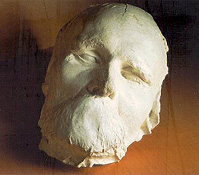
Death mask of Friedrich Nietsche,
German philosopher, 1844-1900, plaster.
![]()
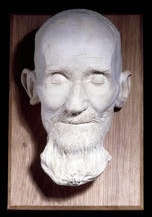
![]()
Charles Smith (English), Death mask of George Bernard Shaw, Irish-English
playwright, 1856-1950.
Also see mask.
debubblizer - A chemical brushed on wax models to prevent bubbles from forming during casting.
Also see feathering.
début de siècle - French for "beginning of the century."
Also see fin de siècle.
![]()

![]()
decagon - A closed two-dimensional polygon bounded by ten straight-line segments. The formula with which to find an equilateral decagon's area is 7.6942 times the length of one side squared.
Also see mathematics, radial, and shape.
decagram or dekagram - A unit of weight measurement equal to 10 grams. To convert decagrams into ounces (US), multiply them by 0.3527. Abbreviated dag and dkg.
decahedron - A polyhedron with ten polygon faces. The plural can be either decahedrons or decahedra.
Related resources:
Also see mathematics, radial, and vertex.
decal and decalcomania - Decalcomania is the process of transferring images from specially prepared paper to the surface of a material such as canvas, glass, or metal. "Decal" is short for decalcomania, and is now more popularly used, often for a sticker, many either decorative or advertising. "Decalcomania" came to English from a similar French word meaning "a craze for transferring a tracing," when the process was very popular, first in France, then in England in the mid-19th century.
(pr. də-KAL and də-KAL-kə-MAY-nee-ə)
Examples:

American, Victor Talking Machine Company, Victrola Label, 1927, decal, 3 1/4 x 2 1/2 inches, placed on the inside of a phonograph playing machine. See logo.
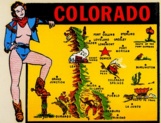
American, State of Colorado, 1960, decal, 3 1/2 x 4 1/2 inches, to be displayed as a souvenir on a motor vehicle. See map.
![]()

American, Autolite Spark Plugs, c. late 20th century, decal, diameter 5 inches. See circle and radial balance.
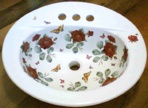
American, a sink decorated with roses and butterflies, c. 2003, ceramic decals on glazed porcelain.
Decalcomania was adopted as a surrealist art process in 1936 by Oscar Dominguez (Spanish, born Tenerife, 1906-1957), who described his technique as "decalcomania with no preconceived object." It involved applying gouache to paper or glass, then transferring a reversal of that image onto canvas or some other material. Max Ernst (German, also lived in the USA, 1891-1976) also practiced decalcomania, as did Hans Bellmer (German, 1902-1975) and Remedios Varo (Spanish, also lived in France and Mexico, 1908-1963).
Related:
Also see automatism, fractal, frottage, inkblot, Rorschach test, transfer paper, and visual culture.
deckle - In papermaking, the upper frame that encloses the wet pulp on the mold. Unlike the mold, the deckle is a frame which is entirely open.
![]()
![]()
![]()
deckle edge - The rough edge of handmade paper formed in a deckle. Also called featheredge.
declivity - A downward slope, as may be observed on a hill or a boss. A slope described as declivitous is an especially steep one. The adjectival form of declivity is declivous.
(pron. də-KLI-və-tee, and də-KLI:-vəs)
Also see fold, kerf, molding, pleat, repoussé, and rugosity.
décollage - The tearing away of parts of posters or other images which were adhered to each other in layers, so that portions of the underlayers contribute to the final image.
(pr. DE-koh-LAHZH)
Décollage should not be confused with collage — which is its opposite — or with décolletage — which is something else altogether.
Example:
![]()
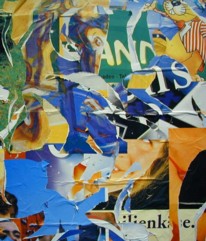
![]()
Mimmo Rotella (born Domenico Rotella) (Italian,
1918-2006), detail of a decollage.
Jacques de la Villeglé (French, 1926-), 122 rue du temple, 1968, a décollage of torn-and-pasted printed paper on canvas, 62 5/8 x 82 3/4 inches (159.2 x 210.3 cm), Museum of Modern Art, NY. A MOMA curator wrote: "Villeglé has devoted his entire career to décollage. He was affiliated with Nouveau Réalisme, a French art movement of the late 1950s and early 1960s devoted to transforming everyday objects and detritus into art in the belief that painting was incapable of conveying the actuality of postwar society."
Also see detritus.
deconstruction - A method of literary criticism that assumes language refers only to itself rather than to a reality outside of a text, that asserts multiple conflicting interpretations of a text, and that bases such interpretations on the philosophical, political, or social implications of the use of language in the text rather than on the author's intention.
Quote:
Also see art criticism, art history, meaning, and realism.
decoration - Something which adorns or embellishes; an ornamentation.
Also see banausic, bookplate, decorative arts, découpage, egg-and-dart, festoon, frieze, gewgaw, hooptedoodle, molding, plaque, and tchotchke.
decorum - Conventions in matching a subject of an artwork to a style or tone appropriate to it. A kind of etiquette expected in the treatment of an artwork's content.
decoupage or découpage - The technique of decorating surfaces by adhering cutouts, most commonly of paper, and then coating with one or more coats of a transparent (or translucent) finish, usually a lacquer or varnish. Or, work produced by this technique. From French.
(pr. DAY-koo-PAHZH)
Example:

Persia (Iran), late 15th-early 16th century,
Page From the Diwan (collected works) of Sultan Husain Mirza,
opaque watercolor,
decoupage, and gold on paper,
8 7/8 x 5 3/4 inches (22.5 x 14.6 cm), Los Angeles County Museum
of Art.
Also see bricolage, collage, coulage, femmage, frottage, fumage, marouflage, montage, parsemage, and photomontage.
decumanus - The east-west road in an Etruscan or Roman town, intersecting the cardo at right angles.
(pr. deck-yoo-MAN-əs)
Also see Etruscan art and Roman art.
deduction - Reaching a conclusion only when it follows necessarily from stated facts or proposals; reasoning from the general to the specific. One cannot contradict such a conclusion without questioning one or more of the premises from which it followed. Also see induction and syllogism.
deed of gift - A contract that transfers ownership of an object or objects from a donor to an institution. It should include all conditions of the donation.
deep, depth - A color
is deep or has depth when is has low lightness and  strong saturation. The opposite
of deep colors in their value — much
lighter, but just as high in saturation — are called brilliant
colors. Opposite to deep colors in saturation — little saturated,
but similarly very low in lightness — are called dark
colors. Opposite to deep colors in both value and saturation
strong saturation. The opposite
of deep colors in their value — much
lighter, but just as high in saturation — are called brilliant
colors. Opposite to deep colors in saturation — little saturated,
but similarly very low in lightness — are called dark
colors. Opposite to deep colors in both value and saturation  are pale
colors. Depth can also refer to the third dimension, either as
actual space or as its illusion.
are pale
colors. Depth can also refer to the third dimension, either as
actual space or as its illusion.
Also see black, brightness, chiaroscuro, darkroom, day for night, night blindness (nyctalopia), nocturne, pastel, reflecting, shade, tenebroso or tenebrism, three-dimensional, and tone.
deesis - From the Greek word δεησις meaning supplication or beseeching.
In art, it is traditionally a representation in Byzantine art of Christ enthroned and flanked by such supplicants as the Virgin Mary, St. John the Baptist, other saints and angels. It is often found on an iconostasis.
(pr. dee-EE-səs)
Examples:

Byzantium, Constantinople, Hagia Sophia, South Gallery or Catechumena, The Deesis, third quarter of the 13th century, mosaic, Istanbul, Turkey. Christ's left hand holds a closed Book of Gospels as he raises his right hand in benediction. His face is strikingly realistic and expressive, as are those of the Virgin Mary and St. John the Baptist, who stand to either side of Christ. All are set against a golden background. The lower portion of the composition has been damaged. This and all other mosaics in Hagia Sophia were covered with plaster at the church's conversion into a mosque in the 15th century. This actually preserved the mosaics for later restoration, which began in 1929, when Mustafa Kemal Ataturk ordered the conversion of the mosque into a museum. See art conservation, Byzantine art, detail, and lacuna.

![]()

Russian, the wooden Church of St. Demetrius, Deesis Icons, c. 1540-1560, tempera on wood panel, Rovne, Svidnik. Although the central section depicting Christ is missing, on the left side are St. John Chrysostom, St. Luke, St. Peter, and St. Gabriel the Archangel, 104.7 x 157.4 x 2.5 cm. On the right side are St. Michael the Archangel, St. Paul, St. Mark, and St. Basil, 107.3 x 159.2 x 2.5 cm. See icon and Russian art.
deface - To destroy, disfigure, or mar a surface.
Related links:
Also see decollage, graffiti, and vandal and vandalism.
definition, define, defining - Definition is the act of conveying fundamental character, while being very specific, clear, and concise. Although it may be a statement expressing the essential nature of something, as in a statement of the meaning of a word, a sign or symbol. In visual terms, definition is the action making definite and clear, as in distinctness of outline or detail, sharp edges or limits, providing clear focus and contrast, as well as high resolution.
Also see ambiguity, analysis, art criticism, description, different and difference, gestalt, implied, jaggies, knowledge, limit and limitation, optical mixing, optics, and perception.definition
deform - To distort or change form.
deformalism - A postmodern tradition of burlesque painting with a tendency toward bad taste and mayhem. In the United States, examples include the late works of Philip Guston (American, 1913-1980), Peter Saul (American, 1934-), Carroll Dunham (American, 1949-), Matthew Ritchie (American, born Britain, 1964-), Inka Essenhigh (American, 1969-), and Takashi Murakami (Japanese, 1962-). The name apparently comes from the works' anti-formalist content, and from its often cartoonishly surreal deformations.
Also see bad art, distortion, fantastic, style, and ugly.
degenerate - Being in decline; having fallen to
an inferior or undesirable state, especially in mental or moral
qualities. Also, a depraved,
corrupt, or vicious person. Because modernism
was so counter to the fascist aesthetic,
Adolf Hitler (German, 1889-1945) branded modernist art entartete
— degenerate or  degenerative.
The fascists favored a strongly classicalstyle in contrast to the prevailing
artworld styles of Cubism, Surrealism,
Expressionism, Dadaism,
and modernism in general. Rather than censor
modernist art, the Nazis confiscated it. In 1937 they removed
more than 20,000 such works from the collections of German individuals
and museums — works by more than 200 artists, including Otto
Dix, Wassily Kandinsky, Paul Klee, Oskar Kokoschka, Ernst Ludwig
Kirchner, Käthe Kollwitz, Emil Nolde, Max Pechstein, Pablo
Picasso, and Kurt Schwitters. With 650 such works, they mounted
an exhibition titled Degenerate
Art ("Entartete 'Kunst'"). The exhibit opened
in Munich and traveled to eleven other cities in Germany and Austria.
In each installation, the works
were poorly hung and surrounded by graffiti and hand written labels
mocking the artists and their creations. Over three million visitors
attended making it the first "blockbuster"
exhibition. The Nazis expected Germans to recognize these works
as presenting "negativity and the incomprehensibility of
the world," which pitted modernist aesthetics
against what fascists characterized as their own positivism, progressive
goals, and noble ideals — an ostensibly hopeful Weltanschauung (world-view)
that led to their ruthlessly forcing their "solutions"
on the world.
degenerative.
The fascists favored a strongly classicalstyle in contrast to the prevailing
artworld styles of Cubism, Surrealism,
Expressionism, Dadaism,
and modernism in general. Rather than censor
modernist art, the Nazis confiscated it. In 1937 they removed
more than 20,000 such works from the collections of German individuals
and museums — works by more than 200 artists, including Otto
Dix, Wassily Kandinsky, Paul Klee, Oskar Kokoschka, Ernst Ludwig
Kirchner, Käthe Kollwitz, Emil Nolde, Max Pechstein, Pablo
Picasso, and Kurt Schwitters. With 650 such works, they mounted
an exhibition titled Degenerate
Art ("Entartete 'Kunst'"). The exhibit opened
in Munich and traveled to eleven other cities in Germany and Austria.
In each installation, the works
were poorly hung and surrounded by graffiti and hand written labels
mocking the artists and their creations. Over three million visitors
attended making it the first "blockbuster"
exhibition. The Nazis expected Germans to recognize these works
as presenting "negativity and the incomprehensibility of
the world," which pitted modernist aesthetics
against what fascists characterized as their own positivism, progressive
goals, and noble ideals — an ostensibly hopeful Weltanschauung (world-view)
that led to their ruthlessly forcing their "solutions"
on the world.
(pr. adjective: də-JE-nər-ət, verb: də-JE-nər-AYT)
Works by some of the artists called
degenerate:
Ernst Barlach (German, 1870-1938), The Avenger, 1914, bronze, Tate Gallery, London. Also see Expressionism. Barlach's work was condemned as "degenerate" by the Nazis, who in 1937 confiscated or destroyed all his works in public collections. See German art.
Max Beckmann (German, 1884-1950), The Skaters, 1932, oil on canvas, 50 1/2 x 38 1/2 inches, Minneapolis Institute of Arts.
Otto Dix (German, 1891-1969), The Journalist Sylvia Von Harden, 1926, oil and tempera on wood, 121 x 89 cm, Georges Pompidou Center, Paris.
Quote:
Related links:
Also see aniconic, gender issues, iconoclast, iconomachy, iconophobia, propaganda, ugly, and xenophobia.
déjà vu - French for "already seen; previously seen." An impression of great familiarity with a place or event which one has never experienced before. The illusion of having already experienced something actually being experienced for the first time. Sensations of this sort have been cited by Plato (Greek, c. 427 - c. 348 BCE) and many others as evidence of reincarnation — that these feelings of familiarity are based on partial memory of a previous life. Contemporary psychologists describe them as startling revivals of actual, but forgotten memories.
Quotation about déjà vu:
"Déjà vu is a glitch in the Matrix." From dialogue spoken by a character in the motion picture The Matrix, 1999, written and directed by Andy and Larry Wachowski (American, contemporary).
Also see attention, consciousness, context, gestalt, knowledge, meaning, memory, optical, optical illusion, perception, seeing, Stendhal syndrome, and subliminal message or subliminal advertising.
delineate - To depict by drawing with a tool which leaves a linear trail behind the drawer's gesture. May also mean, more loosely, to describe.
(pr. də-LIN-ee-AYT)
deltiology and deltiologist - Deltiology is the collecting of picture postcards. A deltiologist is a collector of them. Short of framing them, a preferred means of storing and displaying postcards is in polypropylene sheet protectors.
Example postcards:
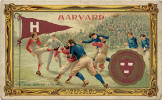
American, Harvard College Football, Murad Company,
1910, postcard, lithograph.
In one corner the Harvard pennant flies. In another, Harvard's
coat of arms is proudly displayed.
And in the middle, Harvard players in crimson play against their
perennial rivals from Yale. See flag.

American, Greetings from South Hill, Virginia,
c. 1955, postcard, lithograph.
In a postcard style popular
in the USA at midcentury, glimpses of local sites have been shaped to fit inside the raised
letters of VIRGINIA. See popular culture and souvenir.
Also see ephemera, exonumia, numismatics, paper, philately, philluminist, printing, scripophily, and solander box.
denatured alcohol - See alcohol.
Denmark - See Danish art.
density - May refer to the variations perceived in the sight of objects near and far due to atmospheric variations — gases, moisture, dust, smoke, and temperature — as well as to seeing through such potentially translucent materials as glass and plastic. Another way to refer to aerial perspective.
Quote:
Also see refraction.
dent - A depression in a surface made by pressure or a hit.
Also see carve, concave, dapping block, declivity, ear, fluted, hammers (ballpein hammer, bush hammer, claw hammer, mallet, manipulate, mortise, relief, repoussé, rugosity, subtractive, and toreutics.
dente di cane - A type of claw chisel having six or so fine notches in its carving edge. Italian for "dog's teeth."
(pr. DEN-tə dee KAH-nə)
deoxidize - To remove oxides. Barium is an example of a deoxidizing substance, because it is used to deoxidize copper, bronze, and some other alloy. Flux is used to deoxidize surface in the process of soldering.
depict - To make an image of, in two or more dimensions.
Also see abstraction, likeness, represent, signify, simulacrum, and trompe l'oeil.
De Ploeg - A twentieth century European art movement. [More soon!]
depth - The third dimension.
 The apparent distance from front
to back or near to far in an artwork.
When depth refers to an object's
smallest dimension, then this distance can also be called its
thickness. When an object
or space is principally viewed
from above, its depth can also be its height.
If an objects's depth is its greatest dimension, then this distance
can also be called its length.
Techniques of perspective
are used to create the illusion
of
The apparent distance from front
to back or near to far in an artwork.
When depth refers to an object's
smallest dimension, then this distance can also be called its
thickness. When an object
or space is principally viewed
from above, its depth can also be its height.
If an objects's depth is its greatest dimension, then this distance
can also be called its length.
Techniques of perspective
are used to create the illusion
of  depth in paintings
or drawings. Examples of these techniques
are: controlling variation between sizes of depicted subject,
overlapping them, and placing
those that are on the depicted ground as lower when nearer and
higher when deeper.
depth in paintings
or drawings. Examples of these techniques
are: controlling variation between sizes of depicted subject,
overlapping them, and placing
those that are on the depicted ground as lower when nearer and
higher when deeper.
Also see aerial perspective, chiaroscuro, direction, herringbone perspective, linear perspective, push and pull, shadow box, sphere, and width.
depth of field - In photography, the distance between the nearest point and the farthest point in the subject which is perceived as acceptably sharp along a common image plane. For most subjects it extends one third of the distance in front of and two thirds of the distance behind the point focused on.
Example:

Abelardo Morell (American, born Cuba, 1948-), Farewell to Arms, 2001, close-up photograph of a page of Ernest Hemingway's book placed at an angle to the camera, with the lens's aperture opened to produce a depth of field which makes the nearest and farthest portions of the page out of focus. Notice that the depth of field permits the viewer to see the paper's texture in sharp focus only in the center of the picture.
Also see differential focus.
Der Blaue Reiter - A group of German artists based in Munich from 1911 to 1914, mostly expressionist painters, but their works ranged from pure abstraction to romantic imagery, attempting to express spiritual truths. Common to the group was a philosophical spirit and certain approaches to technique. The name, meaning "blue rider", was taken from the name of a painting by Wassily Kandinsky (1866-1944), and was also the title of the almanac and the exhibition on which he collaboration with others. Some of the important members of the group were Alexei Jawlensky (Russian, 1864-1941; worked in Germany and Switzerland), Gabrielle Münter (1877-1962), Franz Marc (1880-1916), Paul Klee (1879-1940), and August Macke (1887-1914).
(pr. dər BLOU-ə RI:tər)
Examples:

Alexei Jawlensky (Russian, 1864-1941; worked in Germany and Switzerland), Head, c. 1910?, oil on canvas over cardboard, 16 1/8 x 12 7/8 inches (41 x 32.7 cm), Museum of Modern Art, NY. See Russian art.
Wassily Kandinsky (Russian, 1866-1944), Improvisation XIV, 1910, oil on canvas, 74 x 125.5 cm, Georges Pompidou Center, Paris.
Wassily Kandinsky, Cossacks, 1910-11, oil on canvas, 94.6 x 130.2 cm, Tate Gallery, London.
Wassily Kandinsky, Impression V (Park), 1911, oil on canvas, 106 x 157.5 cm, Georges Pompidou Center, Paris.
Wassily Kandinsky, Mit dem schwarzen Bogen (With a Black Arc), 1912, oil on canvas, 189 x 198 cm, Georges Pompidou Center, Paris.
Wassily Kandinsky, Composition VI, 1913, oil on canvas, 195 x 300 cm, Hermitage Museum, St. Petersburg, Russia.
Wassily Kandinsky, Bild mit rotem Fleck (Picture with Red Marks), 1914, oil on canvas, 130 x 130 x 0 x 0 cm, Georges Pompidou Center, Paris.
Wassily Kandinsky, In the Gray, 1919, oil on canvas, 129 x 176 cm, Georges Pompidou Center, Paris. See Bauhaus.

Gabriele Münter (German, 1877-1962), Interior, 1908, oil on cardboard, 20 1/8 x 26 1/4 inches (51 x 66.4 cm), Museum of Modern Art, NY. See feminist art.

Gabrielle Münter (German, 1877-1962),
Boating, 1910, oil
on canvas, Milwaukee Art Museum,
WI. Münter portrays herself with the oars of the boat, her
back to the viewer, as Wassily Kandinsky stands above fellow
painter Marianne von Werefkin, and a son of Alexei Jawlensky,
another painter.
Paul Klee (Swiss, 1879-1940), They're Biting, 1920, drawing and oil on paper, 31.1 x 23.5 cm, Tate Gallery, London.
Paul Klee, Pflanzenwachstum (Growth), 1921, oil on cardboard, 54 x 40 cm, Georges Pompidou Center, Paris.

Franz Marc (German, 1880-1916), Yellow Cow (Gelbe Kuh), 1911, oil
on canvas, 55 3/8 x 74 1/2
inches, Solomon R. Guggenheim Museum, NY.

Franz Marc, A Deer in the Flower Garden (Reh im Blumengarten),
1913, oil on canvas,
55.3 x 77.4 cm, Kunsthalle, Bremen.

Franz Marc, The Fate of Animals — the trees' rings, the
animals' veins (Tierschicksale — Die Bäume zeigten ihre
Ringe, die Tiere ihre Adern), 1913, oil
on canvas, 195 x 263.5 cm,
Kunstmuseum, Basel, Switzerland.
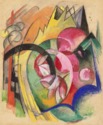
Franz Marc, Colored Flowers, 1913-14, tempera
over pencil on paper,
8 5/8 x 6 5/8 inches (21.9 x 16.8 cm), San Diego Museum of Art,
CA.

Albert Bloch (American, 1882-1961), March of the Clowns, 1941, oil
on canvas mounted
on Masonite, sight: 35 9/16
x 39 7/16 inches (90.3 x 100.2 cm), framed: 41 x 45 inches (104.1
x 114.3 cm), The Jewish Museum, NY. Bloch was the only American born
member of Der Blaue Reiter. See Jewish
art.
Also see Bauhaus, Blaue Vier, and Die Brücke.
derivative - Unoriginal. Owing too much to one or more other artists' work(s). This term is almost always used disparagingly, even though it must be admitted that a high percentage of the art we see is derived from images their producers have seen. Newness is a quality particularly highly prized by adherents to Modernism.
Also see academic, art, banausic, bland, brainstorming, brummagem, buckeye, calendar painting, camp, confection, creativity, decoration, decorative, decorative arts, derived image, kitsch, low art, mediocre, paint-by-number, ornament, picturesque, popular culture, quotations, taste, tchotchke, and ugly.
derived image - In digital imaging, an image that is obtained from another one, usually by eliminating part of it. Common techniques used to create a derived images include taking a detail, subsampling to a lower resolution, using lossy compression, or using image-processing techniques to alter an image. Also called derivative image.
Examples:

Here is an animation
of four pictures, each an arrangement
of colored squares
of decreasing size, increasing
number, and increasing complexity.
As the animation progresses you'll identify the image from which
the images were derived. This experience might be described
as achieving closure or making
a new gestalt. This experience
is also likely to arrive earlier in the sequence
the more times one sees the animation. Even the final image is
actually a greatly distorted
reproduction of the original picture. See metamorphosis
and pixel.
Also see derivative, gestalt, new, original, and originality.
desco da parto - Italian for "commemorative birth tray."
An example:

Giovanni di Ser Giovanni (called Scheggia)
(Italian, Florentine, 1407-1486), The Triumph of Fame; (verso) Impresa
of the Medici Family and Arms of the Medici and Tornabuoni Families,
birth tray, c. 1449, tempera, silver, and gold on wood; overall,
with engaged frame,
diameter 36 1/2 inches (92.7
cm); recto, painted
surface, diameter 24 5/8
inches (62.5 cm); verso, painted
surface, diameter 29 5/8 inches (75.2 cm), Metropolitan Museum
of Art, NY. This desco da parto was commisioned
to celebrate the birth of Lorenzo de' Medici, known to posterity
as Lorenzo the Magnificent (1449-1492).
Also see commemorate.
description - A statement creating a mental image of something experienced, or the act of making such a statement. Not to be confused with interpretation, description is identifying the literal qualities or realistic presentation of subject matter, along with the elements of art found — analyses that can help to make complicated things understandable by reducing them to their component parts. It demands only the facts of what can be seen, often in one or more works of art; and partly two or more works can be described by comparing them to each other.
Quote:
Related link:
Also see art criticism, art history, assessment, bias, brainstorming, examination, formal analysis, meaning, order, text, and visualize.
desensitize - A process in which repeated sensory or cognitive stimulation results in a decreased awareness of those stimulations. To art teachers of special education students, desensitization is the process in which materials or methods are gradually introduced to those who may have an aversion to them. As acceptance begins, quantity and exposure time are increased. This technique is particularly useful in with tactually defensive students.
design qualities - In art criticism, how well an artwork is ordered or put together.
Also see design, principles of design, and quality.
destroy and destruction - To break up, ruin, spoil, wreck, or demolish. The opposite of creating, destruction may not seem to be an artistic act, however creation is impossible without a simultaneous destruction, as a painter destroys a tube or jar of paint, a sculptor destroys a rock or a tree, and a jeweler destroys an ingot of gold. Willful or malicious destruction is antithetical to art however, and is often called vandalism.
Quote:
Also see anti-art, art conservation, art restoration, chaos, deface, detritus, disfigure, distort, distress, fragment, iconomachy, palimpsest, scarification, shard, and Shiva.
detail - An individual, minute, or subordinate part of a whole. A distinctive feature of an object or scene which can be seen most clearly close up. Also, a small part of a work of art, enlarged to show a close-up of its features. It can also refer to finely or carefully designed, crafted, or finished portions (passages) of any composition, as when one pays "attention to the details" — even the little things.
To detail is to add or modify details.
(pr. noun: DEE-tayl, verb: də-TAYL)
Examples:

Jan van Eyck (Flemish, 1395-1441), The Ghent altarpiece, 1432, oil
on panels (triptych
altarpiece), 4 feet 9 1/2 inches
x 6 feet 9 inches, Cathedral of St. Bavo, Ghent, Cathedral of
St. Bavo, Ghent. Details:
Adam
from left wing, Eve from right.
Detail of lower central panel: Worshippers.

José (Jusepe) de Ribera (Spanish,
1591-1652), The Holy Family with Saints Anne and Catherine
of Alexandria, 1648, oil
on canvas, 82 1/2 x 60 3/4
inches (209.6 x 154.3 cm), Metropolitan Museum of Art, NY. On
the Met's page, you can enlarge
any detail in this painting. See Spanish
art.

Richard Dadd (British, 1817-1886), The Fairy Feller's Master-Stroke, 1855-64,
oil on canvas,
54.0 x 39.4 cm, Tate Gallery, London. After murdering his father
in 1843, Dadd was diagnosed as insane and spent the rest of his
life in asylums. Cut off from the outside world, he produced
a series of paintings which combine a remarkable attention to
detail with an individual, manic
intensity. The horror vacui
seen in Dadd's pictures may be a result of his severe mental
illness. See art brut.
Quote:
Also see definition, dominance, emphasis, limitation, Pre-Raphaelite Brotherhood, sketch, telephoto, and zoom.
detergent - A water-soluble wetting agent — cleansing substance — made from chemical compounds rather than the fats and lye used to make soaps.
Also see solve, solvent, and stain and stain removal.
detournement - A turning around, essentially the act of pulling an image out of its original context to create a new meaning. A French word.
Quote:
Also see culture jamming, incongruity, and photomontage.
detritus - Loose fragments that nature or carving has worn away from rock. Often, by extension, the material or debris resulting from the making of any work of art; the disintegrated or eroded material left behind by past civilizations. An example is the granite rubble which sculptor Gutson Borglum (American, 1867-1941) produced as he carved Mount Rushmore National Monument (completed Oct. 31, 1941). For aesthetic and practical reasons he decided to leave the detritus where it fell rather than remove it.
(pr. də-TRI:-təs)
Examples of relationships between works and detritus:
Jackson Pollock (American, 1912-1956), Full Fathom Five, 1947, oil on canvas with nails, tacks, buttons, key, coins, cigarettes, matches, etc., 50 7/8 x 30 1/8 inches (129.2 x 76.5 cm), Museum of Modern Art, NY. A MOMA curator reports: "An assortment of detritus, from cigarette butts to coins and a key, are enfolded by the paint. Though many of these items are obscured, they contribute to the painting's dense surface and churning sensation."
Jacques de la Villeglé (French, 1926-), 122 rue du temple, 1968, a décollage of torn-and-pasted printed paper on canvas, 62 5/8 x 82 3/4 inches (159.2 x 210.3 cm), Museum of Modern Art, NY. A MOMA curator wrote: "Villeglé has devoted his entire career to décollage. He was affiliated with Nouveau Réalisme, a French art movement of the late 1950s and early 1960s devoted to transforming everyday objects and detritus into art in the belief that painting was incapable of conveying the actuality of postwar society."
Also see clay, cleaning art, Collyers' Mansion, fragment, living rock, monument, palimpsest, rhopography, sand, shard, and stone.
deuteranomaly - See colorblind, colorblindness.
deuteranopia - See colorblind, colorblindness.
development - See Stages of Artistic Development.
https://inform.quest/_art